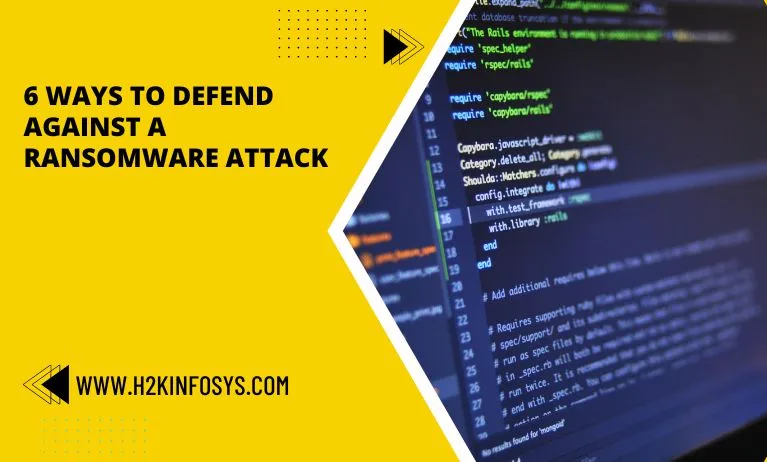Introduction: Why Defending Against a Ransomware Attack Is Critical
Imagine waking up to find your company’s data encrypted, operations halted, and a message demanding payment in cryptocurrency. This is not a sci-fi plot, it’s a ransomware attack, and it’s happening to businesses of every size, every day. The cost of a single ransomware attack can exceed millions of dollars when you consider ransom payments, downtime, and reputational damage.
Whether you are an IT professional, a student in a Cybersecurity training and job placement program, or simply someone passionate about protecting data, understanding how to defend against a ransomware attack is essential.
This blog from H2K Infosys outlines six strategic ways to protect yourself or your organization from a ransomware attack and build career-ready skills.
1. Keep Systems and Software Updated to Block Ransomware Entry
Why It’s Important:
One of the main entry points for a attack is unpatched or outdated software. Cybercriminals exploit known vulnerabilities to gain access to your system.
How to Defend:
- Enable automatic updates for all systems.
- Apply patches immediately when vendors release security fixes.
- Update antivirus tools regularly.
Real Example:
The infamous WannaCry in 2017 spread across more than 150 countries, largely affecting systems that hadn’t applied a known patch.
Career Relevance:
Patch management is a key skill covered in cyber security training courses and is critical in real-world threat mitigation.
2. Backup Strategy: Your Insurance Against a Ransomware Attack
Why It’s Effective:
A well-planned backup system won’t prevent a ransomware attack, but it will ensure you don’t have to pay the ransom. Backups allow fast data recovery with minimal disruption.
How to Defend:
- Follow the 3-2-1 rule: three copies of data, two different media, one off-site.
- Store backups offline or in secure cloud vaults.
- Perform frequent backup tests.
Real-World Success:
A logistics firm was able to fully recover from a ransomware attack in less than 24 hours thanks to a robust, automated backup system.
3. Filter Out Threats Before They Land
Why It’s Critical:
Most ransomware attacks start with phishing emails, which trick users into downloading malicious files or clicking harmful links.
How to Defend:
- Use email filters to detect and block suspicious attachments and URLs.
- Enable web filtering to prevent access to known malicious sites.
- Train employees to recognize phishing attempts.
Security Training Insight:
Email and web filtering are frequently practiced in cybersecurity training near me courses as part of intrusion prevention modules.

4. Limit Access to Reduce Ransomware Impact
Why It’s Smart:
If a ransomware attack infects a device with limited access, the overall impact is minimized. This is why enforcing the Principle of Least Privilege (PoLP) is essential.
How to Defend:
- Give users only the access needed for their job roles.
- Use Role-Based Access Controls (RBAC).
- Audit access logs regularly.
Industry Example:
A university facing a ransomware attack was able to isolate the breach quickly due to tight user permission policies.
5. Use Endpoint Detection and Response (EDR)
Why It’s a Must:
EDR tools monitor devices for suspicious activity and can stop a ransomware attack in its early stages.
How to Defend:
- Install EDR software on all endpoint devices.
- Configure real-time alerts for anomalous behavior.
- Integrate with SIEM for broader analysis.
Hands-On Training:
In advanced cyber security training and placement programs, students configure EDR tools and simulate attacks to build detection expertise.
6. Raise User Awareness to Prevent Human Errors
Why It’s Effective:
Human error is often the weakest link in cybersecurity. Educating users reduces the chances of falling victim to a ransomware attack.
How to Defend:
- Conduct ongoing cybersecurity awareness training.
- Use simulated phishing tests.
- Reinforce password hygiene and safe browsing practices.
Training Application:
Courses focused on Cybersecurity training near me include labs and activities that demonstrate how social engineering fuels many ransomware attacks.
Bonus Security Tactics to Defend Against a Ransomware Attack
- Multi-Factor Authentication (MFA): Stops unauthorized access even if credentials are compromised during a ransomware attack.
- Network Segmentation: Limits the spread of malware during an attack.
- Intrusion Detection Systems (IDS): Identify unusual traffic patterns that could signal a ransomware attack.
How These Defense Tactics Apply to Cybersecurity Careers
Each of the six methods above addresses a unique aspect of defense against a ransomware attack, from technical tools to user training. These are not just useful in their,y but are skills that employers demand in the job market.
When you enroll in a Cyber security training course, you gain hands-on experience in:
- Setting up intrusion detection systems.
- Implementing backup policies.
- Configuring access controls.
- Simulating and responding to ransomware attacks.
Professionals who understand how to prevent and respond to a ransomware attack are in high demand across industries like healthcare, finance, government, and retail.
Key Takeaways
- A ransomware attack is a real and present danger in today’s digital ecosystem.
- With the right mix of strategies, updates, backups, filters, permissions, EDR tools, and user education, you can greatly reduce your risk.
- Each defense technique ties directly into skills taught in cyber security training and job placement programs.
- Employers are actively seeking professionals who can build proactive ransomware defenses.
Conclusion
Don’t wait for a ransomware attack to strike before you act. Equip yourself with the tools, strategies, and confidence to defend against modern cyber threats.
Enroll now in H2K Infosys’ Cyber security training with placement and build practical skills that make a real-world impact.


























